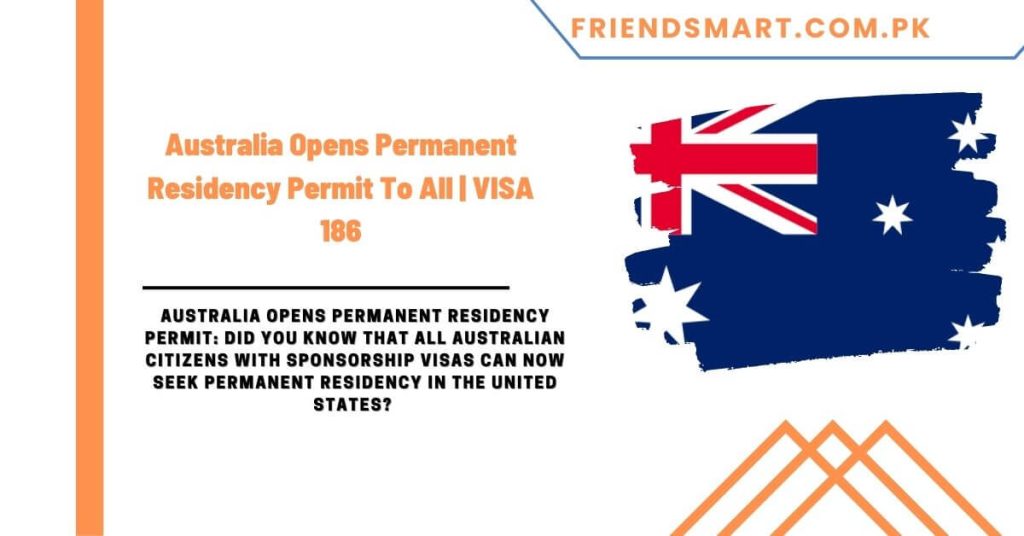Australia Opens Permanent Residency Permit To All | VISA 186

Australia Opens Permanent Residency Permit: Did you know that all Australian citizens with sponsorship visas can now seek permanent residency in the United States? This article describes the precise requirements and adjustments to the 186 Permanent Employer Nomination Visa.
By the end of 2023, all Australians with sponsorship visas, including those whose positions are listed on the STSOL, will be able to apply for Permanent Employer Nomination 186 visas. Furthermore, the examination of the Australian immigration system revealed some promising improvements, some of which confirm the sponsorship visa relationship.
Changes in Sponsorship Visa Details
The subclass 186 visa, also known as the Employer Nomination Scheme visa, is now a type of permanent residency that requires sponsorship from an employer who recommends the candidate. You must work in one of the following occupations to be eligible for either the Transition or Direct Stream of the 186 visas.
The IELTS or a comparable test must yield a total score of 6 in English language skills. Candidates must also be under the age of 45 for the Direct Entry Stream and under the age of 50 for the Temporary Residence Transition Stream at the time of application.
Since the Liberals came to office more than 5 years ago, the eligibility rules for the Australian Category 186 Employer Nomination Visa have remained unchanged.

Since then, the 186 Employer Nomination visa has been available solely to sponsored employees who can nominate positions on the Medium and Long-Term Strategic Skills List, or MLTSSL. Candidates are only eligible for the temporary residency transition stream if they have worked for the sponsoring employer for at least three years.
According to a formal media release, this will change by the end of fiscal year 2022/23. Every Australian resident with a category 482 sponsorship visa will be entitled to seek permanent residence under the newly formed labor administration, which will return things to as they were five years ago.
They can do so under the Employer Nomination Scheme, subclass 186 visa, regardless of whether their occupation is on the STSOL or the MLTSSL. Even better, a sponsorship visa holder will require fewer working years to complete the conditions for permanent residency in Australia.
Instead of working for the same employer for three years, holders of sponsorship visas are eligible after only two years.
Read More: UK Visa Application Process from Pakistan – How To Apply
What are the Requirements?
- The employer must first agree to propose the sponsored employee for a permanent visa.
- Second, the employer’s operation must meet the nomination conditions.
- Third, the visa applicant must meet moral, morals, physical, and English language standards.
As on July 1, 2023, the minimum annual wage package for sponsored visas will be increased. The TSMIT, or Temporary Skilled Migration Income Threshold, will rise from 53,900 to 70,000 each year. Despite the fact that nothing has changed in the last ten years, the administration feels that this is still the direction of progress.
Only applications received on or after July 1, 2023, will be eligible for the amended pay structure. The government will also contribute $630 million to the Australian Border Force and the Department of Home Affairs. This money will be used to improve the country’s immigration rules as well as the country’s existing strong border and national security systems.
People Also Ask
-
What is the new update for 186 Visa Australia?
By the end of 2023, all Temporary Skill Shortage (TSS) visa holders whose employers choose to sponsor them will be able to apply for the Temporary Residence Transition (TRT) stream of the Employer Nomination Scheme (subclass 186) visa.
-
What are the Requirements for 186 Visa Australia
The employer must first agree to propose the sponsored employee for a permanent visa.
Second, the employer’s operation must meet the nomination conditions.
Third, the visa applicant must meet moral, morals, physical, and English language standards.



